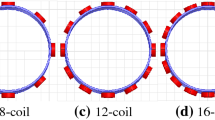Abstract
Electromagnetic tomography (EMT) is a non-invasive imaging technique capable of mapping the conductivity and permeability of an object. In EMT, eddy currents are induced in the object by the activation coils, and the receiving coils can measure the EMT voltages. When the activation frequency is significantly large, we can treat the metallic targets as electrically perfect conductors (EPCs). In this situation, a thin skin approximation is reasonable and this type of scattering problem can be effectively treated by the boundary element method (BEM) formulated through integration equations. In this study, we compute three-dimensional (3D) sensitivity matrix between the sensors due to an EPC perturbation. Efficiency improvement is achieved through the utility of scalar magnetic potential. Two EPC objects, one sphere and one cube shaped, are simulated. The results agree well with the H dot H formula. Overall, we conclude that BEM can be used to calculate the 3D sensitivity matrix of an EMT system efficiently. This method is a general one for any shaped objects while the H dot H solution is only capable of producing the response for a small ball.
Similar content being viewed by others
References
Griffiths H. Magnetic induction tomography [J]. Measurement Science and Technology, 2001, 12: 1126–1131.
Yin W L, Peyton A J, Dickinson S J. Simultaneous measurmensts of distance and thickness of a thin metal plate with an electromagnetic sensor using a simplified model [J]. IEEE Transactions on Instrumentation and Measurement, 2004, 53(4): 1335–1338.
Merwa R, Hollaus K, Biró O, et al. Detection of brain oedema using magnetic induction tomography: A feasibility study of the likely sensitivity and detectability [J]. Physiological Measurement, 2004, 25: 347–354.
Yin W L, Peyton A J, Zysko G, et al. Simultaneous noncontact measurement of water level and conductivity [J]. IEEE Transactions on Instrumentation and Measurement, 2008, 57(11): 2665–2669.
Scharfetter H, Merwa R, Pilz K. A new type of gradiometer for the receiving circuit of magnetic induction tomography (MIT) [J]. Physi ological Measurement, 2005, 26: S307–S318.
Soleimani M, Lionheart W R B, Riedel C H, et al. Forward problem in 3D magnetic induction tomography (MIT) [C]//Proceedings of 3rd World Congress on Industrial Process Tomography. Banff: WCIPT3, 2003: 275–280.
Watson S, Williams R J, Gough W A, et al. A magnetic induction tomography system for samples with conductivities less than 10 S·m−1 [J]. Measurement Science and Technology, 2008, 19: 045501.
Pham M H, Peyton A J. A model for the forward problem in magnetic induction tomography using boundary integral equations [J]. IEEE Transactions on Magnetics, 2008, 44(10): 2262–2267.
Wei H Y, Soleimani M. Four dimensional reconstruction using magnetic induction tomography: Experimental study [J]. Progress in Electromagnetic Research, 2012 (129): 17–32.
Wei H Y, Ma L, Soleimani M. Volumetric magnetic induction tomography [J]. Measurement Science and Technology, 2012, 23: 055401.
Sun K L, O’Neill K, Shubitidze F, et al. Simulation of electromagnetic induction scattering from targets with negligible to moderate penetration by primary fields [J]. IEEE Transactions on Geoscience and Remote Sensing, 2002, 40(4): 910–927.
Morrison J A. Integral equations for electromagnetic scattering by perfect conductors with two-dimensional geometry [J]. The Bell System Technical Journal, 1979, 58(2): 409–425.
Graglia R D. On the numerical integration of the linear shape functions times the 3D Green’s function or its gradient on a plane triangle [J]. IEEE Transactions on Antennas and Propagation, 1993, 41(10): 1448–1455.
Graglia R D. Static and dynamic potential integrals for linearly varying source distributions in two- and three-dimensional problems [J]. IEEE Transactions on Antennas and Propagation, 1987, AP-35(6): 662–669.
Rao S M, Wilton D R, Glisson A W. Electromagnetic scattering by surfaces of arbitrary shape [J]. IEEE Transactions on Antennas and Propagation, 1982, AP-30(3): 409–418.
Feng Ci-zhang. Electromagnetic field [M]. Beijing: Largeer Education Press, 1983 (in Chinese).
Zhang Ze-Ming, Den Yi-Ren. A new method using Biot-Savart law to derive scalar magnetic potential notation [J]. Journal of Chongqing Institute of Civil Engineering and Architecture, 1985 (4): 99–103 (in Chinese).
Yin W L, Peyton A J. Sensitivity formulation including velocity effects for electromagnetic induction systems [J]. IEEE Transactions on Magnetics, 2010, 46(5): 1172–1176.
Author information
Authors and Affiliations
Corresponding author
Additional information
Foundation item: the National Natural Science Foundation of China (No. 50937005), and the Shanghai Maritime University Science and Technology Program (No. 20120064)
Rights and permissions
About this article
Cite this article
He, M., Zhao, Q. & Yin, Wl. Calculation of 3D sensitivity matrix for electromagnetic tomography system using boundary elements and the perturbative approach. J. Shanghai Jiaotong Univ. (Sci.) 19, 302–307 (2014). https://doi.org/10.1007/s12204-014-1503-9
Received:
Published:
Issue Date:
DOI: https://doi.org/10.1007/s12204-014-1503-9
Key words
- electromagnetic tomography (EMT)
- electrically perfect conductor (EPC)
- boundary element method (BEM)
- sensitivity map




